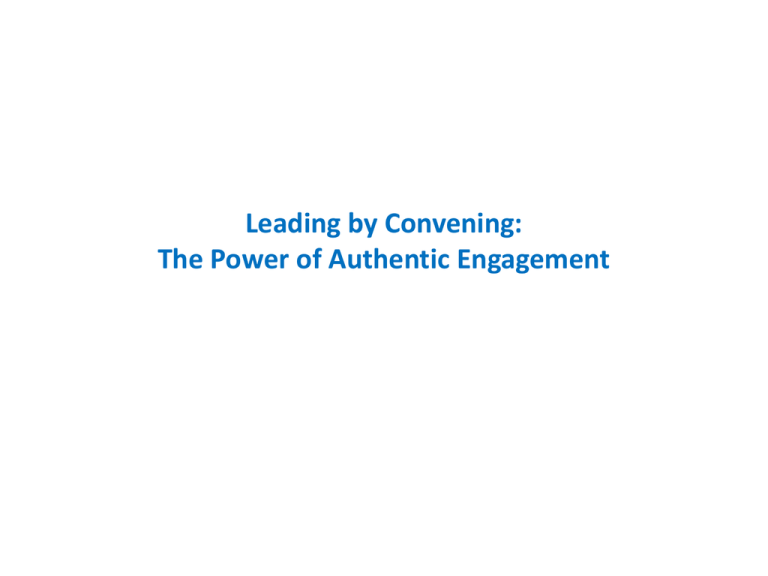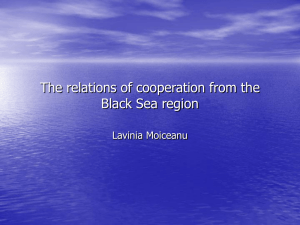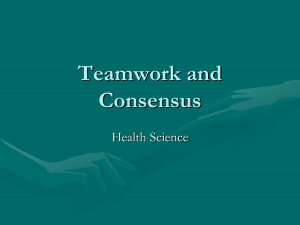Power of Engagement Joanne Cashman Leading By Convening
advertisement

Leading by Convening: The Power of Authentic Engagement The Partnership Way Leading by Convening Habits of Interaction Coalescing around Ensuring Relevant Doing the Work Issues Participation Together Elements of Interaction Adaptive Technical Operational Depth of Interaction Informing Networking Collaborating Transforming Download the Blueprint: www.ideapartnership.org Coalescing around Issues Adaptive/Human Elements Technical Elements 1. Value each and all perspectives 1. Determine the issue 2. Acknowledge individuality of language 2. Seek out and acknowledge related initiatives at differing levels of scale 3. Agree upon the accurate data 3. Develop mission, vision statement, guiding principles, and ground rules of interaction 4. Reach consensus through common understanding in the group 4. Develop process of continued engagement 5. Acknowledge and agree a collective 5. Develop work scope and actionable goals impact is greater than the individual 6. Use a process of reflection impact 6. Agree to move on specific actionable goals Coalescing Around issues Depth of Interaction Coalescing around Issues Informing Level Networking Level Collaborating Level Transforming Level (sharing/sending) (exchanging) (engaging) (commitment to consensus) Acknowledging and valuing diversity Core group of interested stakeholders disseminate information to potential interested stakeholders, across roles, to inform about issues and invite into the discussion Stakeholders from diverse roles exchange ideas and resources with one another; Clarification on role-specific vocabulary is at beginning stages; Outreach to others with a specific focus on roles not yet involved continues Diverse stakeholders engage in dialogue about issues; Differences are acknowledged and explored; A common vocabulary begins to emerge Diverse stakeholders with diverse perspectives are engaged through multiple ways in active collaborative dialogue about issues in order to reach consensus about priorities and future research, policy, and practice opportunities Researching and agreeing on relevant data Personal and professional experiences (anecdotal) are the primary source of evidence for consideration Stakeholders consider what other data beyond personal stories could be a source of evidence and begin collecting relevant data and resources Stakeholders identify relevant data from across disciplines, examine for common themes and understanding (collective analysis) Through consensus, stakeholders agree on the anecdotal and research data from various perspectives and sources relevant to the issue Core group identifies an issue of importance Stakeholders contribute to the discussion bringing in other perspectives Stakeholders take into consideration the whole issue, develop a common understanding, and develop areas of agreement Through consensus, stakeholders determine the specific aspects of the issue that the group will move forward to influence Core group intentionally shares with others, who are not already stakeholders, the reason for caring about this issue; Meeting one on one with targeted persons/ organizations/etc. Stakeholders are intentional about inviting new members into the group work; Being purposeful in getting the people in the same room to work together Stakeholders develop grounding documents (mission, vision, guiding principles, and ground rules; Stakeholders develop and agree on a process of continued communication that fits their needs Through consensus, stakeholders develop a set of actionable goals that define the work scope of the effort; Relationships have been built for strategic advantage Decision-making through consensus Coalescing to move to future work together Ensuring Relevant Participation Adaptive/Human Elements Technical Elements 1. Demonstrate a commitment to inclusion and participation 1. Implement a process of welcoming and orienting 2. Engage stakeholders who are representative, relevant, purposeful, knowledgeable, and influential 2. Develop guidance on when to convene 3. Develop and follow communication protocol 4. Contribute to and create a shared 3. Acknowledge disagreement as part vocabulary of the process to move forward 5. Conduct an environmental scan 4. Engage through leadership; begin 6. Use a process of reflection with a skilled facilitator; continue through shared leadership Ensuring Relevant Participation Depth of Interaction Ensuring Relevant Participation Ensuring diversity among relevant stakeholder representatives Creating opportunities for engagement on the issue Working together to facilitate understanding of the issue and diverse perspectives Evolving leadership roles Informing Level (sharing/sending) Core group of interested stakeholders disseminate information to potential interested stakeholders, across roles, to inform about issues and invite into the discussion Networking Level (exchanging) Stakeholders from diverse roles exchange ideas about who else might be important to this issue (relevant stakeholders); Outreach to others with a specific focus on roles not yet involved continues; Ideas about method preferences, accessibility, and responsibilities are exchanged Collaborating Level (engaging) A process of welcoming and orienting is in place for new members; Inclusion and participation supports are in place Transforming Level (commitment to consensus) Supports for participation are a natural way of working together; Each and all in the group take responsibility for inviting and orienting new members of the group Core group of interested Stakeholders share preferences stakeholders invite others to for on-site and virtual methods of participate in various ways (on- or communication off-site) Group develops guidance on when to convene; Stakeholders consider suggested communication methods that meet the needs of the members and match methods with purposes and/or types of engagement activities The group considers and utilizes, as appropriate, multiple methods for engagement (online, face-toface, conference calling, etc.; Methods are utilized and modified as needed; Flexibility in method use is demonstrated Core group initiates an environmental scan to determine who else has resources to contribute to the work Stakeholders from diverse roles exchange information, share work that has been done previously; An environmental scan is conducted and others with expertise, materials, and resources are invited into the group Stakeholders contribute to and create a shared vocabulary; They reach across systems in reviewing, critiquing, and revising/confirming the issue to be addressed Stakeholders demonstrate disagreement is a way to reach agreement; A common vocabulary is used; The question of who else needs to be involved continues to be addressed The core group identifies and shares a variety of different roles and functions that can occur within the group as it evolves Stakeholders discuss roles and responsibilities and determine who is interested in assuming specific roles for distinct periods of time or in relation to a particular sub-issue or activity; Flexible leadership is emerging Group members are working together and assuming roles and responsibilities appropriate to their knowledge, skills, and interests; Shared leadership is emerging Shared responsibility and accountability for all roles and activities is evident; Roles are flexible and different people assume them at different times, as needed Doing Work Together Adaptive/Human Elements Technical Elements 1. Value and appreciate diversity in participants and interactions. 1. Develop and maintain principles for interaction and engagement. 2. Model and demonstrate respect for and among all participants. 2. Develop a structure for convening and working together. 3. Practice shared leadership. 3. Create and maintain systems to support group interactions. 4. Encourage and support participants’ personal investment in the value of the work. 5. Acknowledge the human need (individual and group) for recognition. 4. Identify levels of potential interaction/influence. 5. Develop and implement an action plan. 6. Use a process of reflection. Doing Work Together Depth of Interaction Doing the Work Together Engaging diverse participants in completing the relevant work Evolving leadership roles Working together to understand and articulate the issue Working together to plan and implement action Informing Level (sharing/sending) Networking Level (exchanging) Collaborating Level (engaging) Transforming Level (consensus decision-making) The expanded group (after coalescing) informs others about the proposed work and the anticipated outcomes, along with the opportunity to participate. Each group agrees to become the conduit for their members to learn and be involved. Stakeholders work together to share unique perspectives and begin the work. Efforts to find others who might be important to this work are ongoing and intentional. Partners who have experienced working together with a diversity of individuals cannot think of any other way to work. This type of engagement is internalized and expected. The expanded group informs their constituents that the effort is underway and opportunities for engagement continue. Stakeholders share levels of expertise in organization, facilitation, etc.. Members begin to identify and ask individuals to facilitate certain activities. Meeting facilitation is shared among members of the group. Flexibility in leadership is evident based on comfort and skill levels of the individuals. Members of the group demonstrate willingness to work together to accomplish a common goal. Flexibility in leadership is evident. When designated facilitator becomes unavailable another steps up from the group. The expanded group communicates evolving ideas, issues and resources. The expanded group seeks opportunities for their constituents to respond to the current ideas, issues and resources. Stakeholders consistently revisit their structures for interaction and revise as needed. Group members agree and clearly articulate the work through the products created and/or their discussions with others. The expanded group identifies strategic ways in which to customize messages for their audience and help them to act. Participants exchange ideas about the work and how it could be accomplished, possible action steps and timelines. Through shared decisionmaking, stakeholders create a well-developed action plan. They share responsibility and are actively engaged in implementation of the plan. Transparency and open communication occurs between and among different levels. Vertical and horizontal influence occurs as a result of implementation of the action plan. Practitioners influence policy, policy influences practice. Group Change: Toward a Culture of Collaboration Informing Level (sharing/sending) Leading by Convening Evaluating and showcasing collective influence through accomplishments and positive outcomes Disseminating program outcome data to interested stakeholders Sharing success stories (anecdotal) Networking Level (exchanging) Exchanging ideas about what we think and believe was successful and has been accomplished Collaborating Level (engaging) Determining together what constitutes the standards for success Reviewing together work based upon these standards Transforming Level (consensus decision-making) Identifying, sharing and celebrating accomplishments Looking for opportunities to influence change as a result of these accomplishments Considering opportunities for replication and generalization Observing there is vertical and horizontal influence that occurs as a result of this work Individual Change: Toward a Different Identity as a Collaborator Depth of Interaction Leading by Convening I am a learner and a leader When meeting a new challenge/issue, I cross environments by… I rely on a blended leadership style to address new challenges/issues by… Informing Level (sharing/sending) stating clearly that I am here to learn from others stating clearly that I am willing to share leadership consciously seeking out others with interest in the challenge/issue and sharing my information and questions with them consciously ensuring that others I seek out are coming from differing roles/ experiences/perspectives analyzing data around the issue sharing my perspectives with others asking others to share data and perspectives Networking Level (exchanging) acknowledging leading comes through skill development asking others to come to the table as learners and to lead as they feel comfortable exchanging questions, ideas and resources with one another clarifying role-specific vocabulary consciously asking who or what perspective is still needed to make the best decisions and inviting them into the conversation listening carefully to what others have to share asking clarifying question offering possible solutions Collaborating Level (engaging) relying on leadership from those with influence and expertise as needed knowing that in the role of leader I am still a learner Transforming Level (consensus decision-making) moving with ease in and out of the learner and leader roles engaging in dialogue about the challenge/issue with as many differing perspectives “in the room” as possible utilizing communication systems that support working across environments (conference calls, electronic media, etc.) calling on others in the group to lead or facilitate discussions ensuring that each has an opportunity to share encouraging consensus decision-making consciously building relations that attend to the human as well as the technical side of working together no longer needing to bring the process of crossing environments to the conscious level inviting and engaging with others automatically using with automaticity activities/strategies that support relationshipbuilding acknowledging that each and all stakeholders have a role and their interactions produce value Leading by Convening means we….. • Meet people ‘where they are’ on the issue. • Bring people together to build support for addressing the issue. • Convene the stakeholders to discover why this is important and how it will improve practice. • Translate complex challenges into ways that individuals can contribute. • Help people ‘lead in place’ regardless of role, position, or title. • Create new knowledge together. • Solve complex issues that need the various perspectives/aspects that contribute to problems/solutions. • Build a personal commitment to working in this way because we believe inclusive work is better and more sustainable work. • Cultivate the habit of collaboration. • Shape the identity of the group and the individual as collaborators. • Other…..






